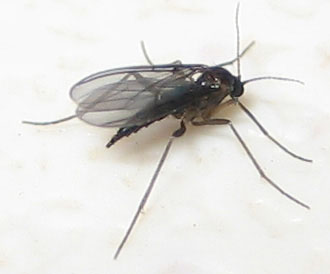

It is extremely aggravating to water your plants only to see little tiny black bugs fly out and into the air surrounding the plant. If this happens to you, there is a good chance you have just encountered fungus gnats. These little black nuisance bugs lay their eggs in the soil of both indoor and outdoor plants.
Just one or two gnats don’t normally pose a problem for a healthy plant, but unfortunately, they increase exponentially in population within a few days. In fact, an adult female can lay up to 200 eggs at one time. As they grow, the larvae and young gnats feast on the organic material and decaying roots or vegetation present in soil. The larvae can do enough damage to the roots to make the plant more susceptible to plant diseases and root rot diseases.
These fungus gnats like an environment that is moist and humid and are often seen in larger numbers after cool and rainy days.
Do-it-yourself management
Because the gnats’ food source is more attractive when the soil is wet, it can be helpful to allow the soil to dry in between watering. Soil that is continuously kept moist becomes very attractive to an egg-laying gnat.
You may also wish to change your potting mix. Newer potting mixes that contain a higher level of fresh compost tend to have more fungus gnats that older potting mix. However, if you like the newer potting mixes, you can use these for your plants and then add a half inch of sand to the top of the plant. The gnats never get too deep into the soil and won’t go through the sand to get to a food source.
There are some over the counter products that can be used to kill these little pests, but they usually only work on the adults, so continual treatment is required. Some plant owners find success with home remedies such as vinegar traps or using a mild soapy water spray on the plants.
Outdoor treatment
It’s important to keep compost and rotting material out of your garden beds. If you’ve just had a heavy rain, use a rake to turn the soil or mulch over every once in awhile until it gets thoroughly dried out, as wet soil and mulch attract these gnats. Just like the indoor plants, you can use a top layer of sand to encourage these gnats to go elsewhere.
You will also want to remove any areas with standing water, such as bird baths or kiddie pools.
For severe infestations or any infestations that don’t respond to do-it-yourself solutions, it’s always best to call a professional.
